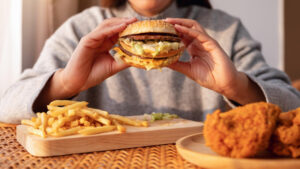Do you often feel that burning sensation after a meal, feeling like your oesophagus is staging a protest? You’re not alone. Acid reflux affects many, but the right diet can dramatically shift the balance from discomfort to relief.
Following simple diet tips for acid reflux in a busy Singapore life can work wonders. Find out how a few tweaks can make a lasting difference.
Understanding Acid Reflux
Acid reflux or gastro‑oesophageal reflux disease (GORD) occurs when stomach acid flows back into the oesophagus, irritating the lining and causing that familiar burning feeling. Diet plays a major role in either worsening symptoms or soothing them. By choosing the right foods and habits, you can take control and ease discomfort naturally.
1. Embrace Low‑Acid Foods
Switching to low‑acid ingredients helps keep the stomach’s pH balance in check:
- Oatmeal, whole‑grain bread, brown rice: These fibre-rich staples help absorb excess acid.
- Bananas and melons: Naturally low‑acid fruits that provide gentle sweetness.
- Leafy greens and root vegetables: Think spinach, kale, and carrot packed with vitamins and easy on your digestive tract.
Avoid citrus fruits (oranges, lemons) and tomato‑based dishes when managing reflux.
2. Lean Proteins with a Lite Touch
Fatty foods can relax the lower oesophageal sphincter (LES), leading to more reflux. Opt for:
- Skinless chicken, turkey, or fish: These are lower in fat, easier to digest.
- Plant proteins like tofu and lentils: Rich in nutrients and kind for digestion.
- Egg whites or whole eggs (in moderation): High‑quality protein with minimal reflux risk.
3. Small, Frequent Meals
Large meals can push stomach contents back up. Instead:
- Eat 4-5 smaller meals instead of 3 big ones.
- Take time, chew slowly, pause between bites.
- Avoid lying down for at least 3 hours after eating.
These habits support digestion and reduce reflux episodes naturally.
4. Smart Snack Choices
When hunger strikes between meals, reach for reflux‑friendly options:
- Almonds (a handful): Good fats that don’t relax the LES.
- Low‑fat yoghurt (under 10% fat): Cooling and soothing but avoid full‑fat versions.
- Ginger infusion: Naturally calming to the digestive system and easy on the stomach.
5. Stay Mindful with Beverages
What you drink matters just as much as what you eat:
- Opt for water or herbal teas (e.g. chamomile, licorice root).
- Say no to coffee, alcohol, fizzy drinks, and citrus juices, all known reflux triggers.
- Keep it tepid: very cold or hot drinks can worsen symptoms.
6. Lifestyle Tweaks that Complement Food Choices
Your daily habits can amplify or alleviate symptoms:
- Maintain a healthy weight: Excess weight can add pressure to the abdomen.
- Avoid tight clothing around the waist.
- Sleep elevated: Try a wedge pillow to keep acid where it belongs.
Why These Diet Tips Matter
By adopting these diet tips for acid reflux, combining low‑acid foods, lean proteins, portion control, kindness in snacking and hydration, plus lifestyle tweaks, you’re not just masking symptoms, you’re treating root causes.
Ready to Reclaim Comfort?
Living reflux‑free is well within reach. At GastroClinic, our team offers tailored nutritional advice and guidance designed to complement medical evaluation. If you’re tired of discomfort and restless nights, book a consultation with GastroClinic today and take the first step towards lasting digestive health.













